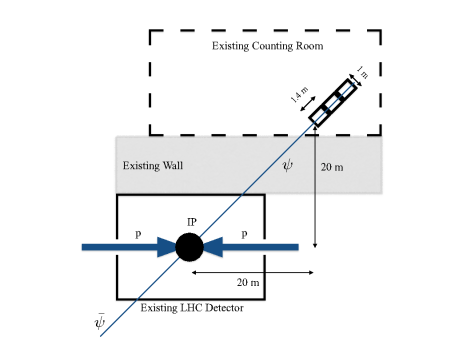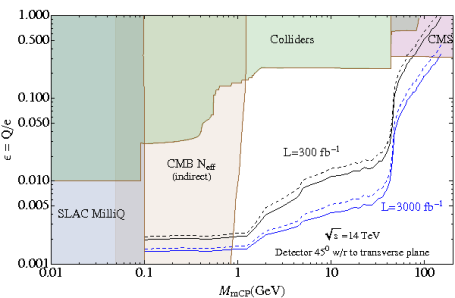Looking for milli-charged particles at the LHC
November 9, 2014 at 10:21 am 2 comments
Andrew Haas, Chris Hill, Eder Izaguirre and Itay Yavin posted an interesting and imaginative proposal last week to search for milli-charged particles at ATLAS and CMS (arXiv:1410.6816) and I think it is worth taking a look.
Milli-charged particles can arise in some models with extra gauge bosons. The word “milli-charged” refers to the fact that the electric charge is much less than the charge of the electron. Such small charges do not arise due to some fundamental representation in the gauge theory. Rather, they arise through a (kinetic) mixing of the new gauge boson with the hyper charge field Bμ. If e’ is the charge associated with the new gauge boson and κ controls the degree of mixing, then the electric charge of the new particle ψ is ε = κe’ cosθW/e. The weak charge is smaller by a factor of tanθW. So the motivation for the search is good and the phenomenology is clear enough, and general.
A pair of hypothetical milli-charged particles would be produced through the Drell-Yan process. There are contributions from both virtual photon and Z exchange; nonetheless, the cross section is small because the charge is small. If the milli-charged particles are light enough, they can also be produced in decays of J/ψ and Υ mesons. The authors provide a plot:
Detecting a milli-charged particle is not easy because the ionization they produce as they pass through matter is much smaller than that of an electron, muon or other standard charged particle. (Recall that the ionization rate is proportional to the square of the charge of the particle.) Consequently, the trail of ions is much sparser and the amount of charge in a ionization cluster is smaller, resulting in a substantially or even dramatically reduced signal from a detector element (such as a silicon strip, proportional wire chamber or scintillator). So they cannot be reliably reconstructed as tracks in an LHC or other general-purpose detector. In fact, some searches have been done treating milli-charged particles as effectively invisible – i.e., as producing a missing energy signature. Such approaches are not effective, however, due to the large background from Z→νν.
A special detector is required and this is the crux of the Haas, Hill, Izaguirre and Yavin proposal.
This special detector must have an unusually low threshold for ionization signals. In fact, normal particles will produce relatively large signals that help reject them. Clearly, the sensitivity to very small milli-charges, ε, is determined by how low the noise level in the detector is. The main problem is that normal particles will swamp and bury any signal from milli-charged particles that may be present. One needs to somehow shield the detector from normal particles so that one can look for small-amplitude signals from milli-charged particles.
Fortunately, the main challenge of detecting milli-charged particles turns out to be a virtue: normal particles will eventually be absorbed by bulk matter – this is the principle behind the calorimeter, after all. Milli-charged particles, however, lose their energy through ionization at a much slower rate and will pass through the calorimeters with little attenuation. This is the principle of the beam-dump experiment: look for particle that are not absorbed the way the known particles are. (Implicitly we assume that the milli-charged particles have no strong interactions.)
The authors propose to install a carefully-crafted scintillator detector behind a thick wall in the CMS and/or ATLAS caverns. Typically, electronic readout devices for the normal detector are housed in a shielded room not far from the detector. This new scintillator detector would be installed inside this so-called counting room.

Schematics drawing showing how the scintillator detector would be placed in a counting room, away from the interaction point (IP)
The scintillator detector is not ordinary. It must be sensitive to rather small ionization signals which means the amplification must be large and the noise rate low. In order to fight spurious signals, the detector is divided into three parts along the flight path of the milli-charged particle and a coincidence of the three is required. In order to fight backgrounds from ordinary particles produced in the pp collisions, the detector is segmented, with each segment subtending only a very small solid angle: essentially each segment (which consists of three longitudinal pieces) forms a telescope that points narrowly at the interaction point, i.e., the origin of the milli-charged particles. Even with many such segments (“bars”), the total solid angle is miniscule so only a very small fraction of the signal would be detected – we say that the acceptance is very small. Sensitivity to the production of milli-charged particles is possible because the luminosity of the LHC will be high. Basically, the product of the cross section, the acceptance and the luminosity is a few even though the acceptance is so small. The authors estimated the reach of their experiment and produced this figure:
It is worth pointing out that this detector runs parasitically – it will not be providing triggers to the ATLAS or CMS detectors. Its time resolution should be good, about 10 ns, so it might be possible to correlate a signal from a milli-charged particle with a particular bunch crossing, but this is not really needed.
The upcoming run will be an exciting time to try this search. Evidence for milli-charged particles would be a huge discovery, of course. I do not know the status of this proposal vis-a-vis CERN and the LHC experiments. But if a signal were observed, it would clearly be easy to enhance it by building more detector. My opinion is that this is a good idea, and I hope others will agree.
Entry filed under: Particle Physics.
2 Comments Add your own
Leave a comment
Trackback this post | Subscribe to the comments via RSS Feed


1. Isabell García | August 17, 2020 at 12:32 am
Isabell García | August 17, 2020 at 12:32 am
hi,
I have checked so many website, your website is very amazing. you should try this
website
2. Emma johnson | October 11, 2022 at 2:11 am
Emma johnson | October 11, 2022 at 2:11 am
I got know your article’s Content and your article skill both are always good. Thanks for sharing. I really appreciate you. You should also check my article.
Mahadev Book